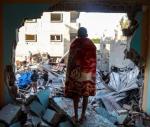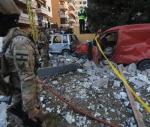You are here
Obama’s mistake nearly 3 years ago
Jul 02,2014 - Last updated at Jul 02,2014
The Obama administration is still living in fantasy land as it tries to deal with the insurgencies in Syria and Iraq.
The administration’s approach to the crises in these countries is even more fantastic than the line peddled by the Bush administration, which was that Baghdad was involved in the attack on the US in 2001 and possessed weapons of mass destruction, posing a threat to the US.
This line, used to justify the 2003 US war on Iraq, was known at that time to be fantasy and was, in fact, based on flagrant lies.
A week ago, President Barack Obama asked Congress to supply $500 million to train and arm “moderate” Syrian rebels, although there are few “moderate” Syrian rebels left and many corrupt figures “on the take” from the gullible US.
If Congress provides the funds Obama has requested and this aid is delivered, it is likely that the conflict in Syria will continue and the sectarian violence in Iraq will grow into a full-scale communal war.
US Secretary of State John Kerry compounded Obama’s nonsense by arguing that “moderate” Syrian rebels can fight Al Qaeda-connected jihadists in Iraq.
This is a fantastic statement.
The jihadists in Syria finished off the “moderate” rebel factions by recruiting most of their fighters who took with them the arms they were given by the US and its Western and Arab allies.
Other rebels sold their weapons and other equipment to jihadists, abandoned arsenals when under attack, or accepted the Syrian government’s offers of amnesty, handed in their arms, and either went home or were pressed into army service.
Furthermore, it is likely that many of the 2,000 Syrian fighters trained by US special forces since 2012 have gone over to Al Qaeda franchise Jabhat Al Nusra, Al Qaeda renegade Islamic State of Iraq and the Levant (ISIL) or to non-Al Qaeda fundamentalist factions which seek to fuse portions of Syria and Iraq into a jihadist-run emirate.
Ignoring what has happened with “vetted” fighters already trained and sent into the field, the new US mission is to “save Iraq” from ISIL by providing training and arms to more “vetted” fighters who, at the first opportunity, will join ISIL, the most successful group on the ground in both Syria and Iraq.
ISIL will be the winner and both Syria and Iraq, fighting for their very existence, will be the losers.
Kerry made his statement in Jeddah after meeting Ahmad Jarba, head of the expatriate opposition Syrian National Coalition, a fantoush collection of squabbling factions and individuals that has no presence or credibility in Syria.
Kerry made the point that Jarba belongs to the Shammar tribe, that straddles the Syria-Iraq border and is present in Jordan and Saudi Arabia. This was meant to mean Jarba understands the situation.
But Kerry gave a misleading impression.
While the Shammar is also the tribe of Saudi King Abdullah’s mother and some of his wives, it supplies Saudi recruits in ISIL and some elements in the Syrian branch, to which Jarba belongs have been allied to the government during the conflict in that country.
While Kerry was talking to Jarba in Jeddah, the expatriate opposition chose to demonstrate its divisions.
Ahmad Tohme, who heads the opposition government in exile, sacked the military command of the non-existent “Free Army”, citing corruption as the cause.
Jarba promptly rescinded Tohme’s decree and threatened to stage a vote of no-confidence in Tohme.
The “power struggle” goes on in the “powerless” coalition, this time over a “Free Army” of “moderate” rebels that does not exist.
In response to the rapid rise of ISIL and its local partners in Iraq, the US sent 300 military advisers to do something about the collapsing Iraqi army which failed to counter the offensive by a few thousand ISIL and allied fighters.
It is not clear what these advisers can do.
Dissolved after the US invasion, the Iraqi army has been reconstituted, trained and armed by the US at a cost of $25 billion. However, this army is not a “force to be reckoned with”, despite US efforts to build a military machine capable of maintaining Iraq’s internal order, integrity and sovereignty.
On paper, the Iraqi army has 193,000 men, 330 tanks, 3,700 armoured troop carriers, and a budget of $17 billion.
Reportedly, 60 of the 243 Iraqi combat battalions melted away and abandoned their equipment when ISIL and allies seized Mosul, Tikrit and other towns and villages.
Overall, five of the army’s 14 divisions are not viable due to the sacking of Sunni and Kurdish commanders and corruption.
“Ghost soldiers” — names on pay lists — reduce the number of men actually serving.
Some 35,000 Kurdish peshmerga militiamen incorporated into the regular army are more loyal to the Kurdish leadership in the autonomous region than to Baghdad.
Therefore, peshmerga units, deployed near the Kurdish region cannot be counted upon when it comes to defending the rest of Iraq.
Furthermore, if there is a major breach between Baghdad and Erbil, the Kurds are capable to muster enough fighters — some say 80,000 to 240,000 — to defend the territory they hold, including “disputed” lands, such as Kirkuk and its oilfields, against any attempt mounted by Baghdad to retake this territory.
When the ISIL offensive began, the Iraqi air force consisted of three Cessna trainer planes — two of which are out of action — and 26 attack helicopters.
Iraq has now received five second-hand Russian warplanes and is awaiting delivery of 36 F-16 fighter jets and 24 Apache helicopters, some of which are due in September.
Saddam Hussein’s army used to boast a million men but could field, perhaps, only half that number. This was certainly a more serious force than the present under-strength Iraqi army, which critics of Prime Minister Nouri Al Maliki say he transformed into his personal militia.
This happened over time and not since the end of 2011 when the US pulled its troops out of Iraq, proclaiming “mission accomplished” although the mission of “saving Iraq” from Saddam was based on false premises.
The rise of ISIL in Syria and Iraq is a direct consequence of Obama’s August 18, 2011, declaration that “the time has come for President Assad to step aside”.
This was a fantastic demand to put to a man who had no intention of standing down and had, on his side, the Syria army, security forces and a fair percentage of the populace.
Assad was — and is — not in the same position as the presidents of Tunisia and Egypt were when mass uprisings prompted the armies to oust them.
Basing his calculations on what happened in Tunisia and Egypt, Obama misread the situation in Syria then and continues to misread it now because he refuses to back down on his demand for Assad to “step aside”.
Obama’s failure to admit that he made a mistake nearly three years ago has cost tens of thousands of lives in Syria and could reap a similar toll in Iraq.













